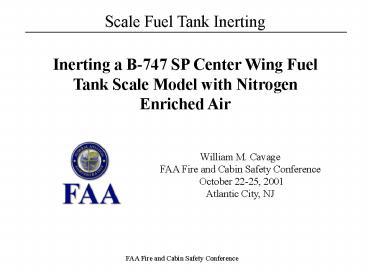Ground Based Fuel Tank Inerting - PowerPoint PPT Presentation
Title:
Ground Based Fuel Tank Inerting
Description:
Inerting a B-747 SP Center Wing Fuel Tank Scale Model with Nitrogen Enriched Air William M. Cavage FAA Fire and Cabin Safety Conference October 22-25, 2001 – PowerPoint PPT presentation
Number of Views:90
Avg rating:3.0/5.0
Title: Ground Based Fuel Tank Inerting
1
Inerting a B-747 SP Center Wing Fuel Tank Scale
Model with Nitrogen Enriched Air
William M. CavageFAA Fire and Cabin Safety
Conference October 22-25, 2001 Atlantic City, NJ
2
Outline
- Background
- Model
- Instrumentation
- NEA Distribution
- Equations
- Test Data
- Summary
3
Background
- FAA is Seeking to Improve Upon Existing Fuel Tank
Safety in Fleet in the Wake of TWA800 Air
Disaster - Inerting of Fuel Tanks Could Provide Significant
Fuel Tank Protection. Most Available Data on
Fuel Tank Inerting for Rectangular Box - Focus of the Testing is to Validate Existing
Assumptions for Inerting Complex Geometric Spaces
(Commercial Transport Fuel Tanks) as Compared to
Simple Rectangular Boxes - Also, Use Model to Determine the Most Efficient
Deposit Configuration
4
Description of Model
- Quarter-Scale Model of Boeing 747 SP CWT was
Built from Three Quarter Inch Plywood By Scaling
Drawings from Shepherd Report - 24 length Scale (1.2 Volume)
- Spars and Spanwise Beams Simulated with Quarter
Inch Plywood Installed in Slats with Scaled
Penetration Holes - Vent System Simulated with PVC Tubing Plumbed to
an Aluminum Vent Channel Adhered to a Plywood Top - Removable Lid to Allow for Model Maintenance and
Modification
5
Photo of Model
6
Instrumentation
- Oxygen Sensor in Each Bay and in One Vent Channel
- Sample Returned to Each Bay to Have Minimal
Effect on Inerting Process - Sensors Plumbed in Unique Sample Drafting
Method - Sensor Remote From Analyzer
- Thermocouple in Each Bay to Detect Temperature
Changes During Testing - NEA Generator Equipped with Oxygen Analyzer
- Calibrated and Checked before Each Test
- Used to Calibrate all Other Sensors
7
B-747 SP Bay Diagram with Volume Data
Dry
1
2
3
4
5
6
Reported Volume 1775
Percent Difference 4.47
8
NEA Distribution System
- Variable Manifold Allows for Depositing NEA in
Any and All Bays of the Tank at Different Flow
Rates - Accepts Output of NEA Generator and is Plumbed to
a Bank of Flow Meters - Two Flow Meters in Parallel for Each Bay to Allow
for Both Large and Small Deposit Quantities - Measure Meter Back Pressure for Accurate Flow
Reading - Used Directing Nozzles on NEA Deposit Fittings
for Some Uneven Deposit Cases
9
NEA Distribution System Diagram
10
Equations Used
Volumetric Tank Exchange (VTE)
Weighted Volumetric Average
Inerting Solution (Perfect Mixing)
Empirical Solution (FAA Ullage Washing Data)
11
Cross-Vented Configuration Data
- Inerted Tank Several Times with Different NEA
Oxygen Concentrations with the Goal of Balancing
the Flow into Each Bay to Obtain Equal Inerting - Used the Volumetric Average Developed to Make
Comparisons with Other Inerting Runs - Results As Expected and Consistent with Previous
Testing but New Numbers Point Toward a VTE of 1.6
for 95 NEA - Depositing in and Uneven Manner Can Simplify
Manifold and Have No Negative Impact on the
Inerting Process
12
B-747 SP Scale Fuel Tank Inerting Data
13
B-747 SP Scale Fuel Tank Inerting Data
14
B-747 SP Scale Fuel Tank Inerting Data
15
B-747 SP Scale Fuel Tank Inerting Data
16
B-747 SP Scale Fuel Tank Inerting Data
17
Blocked Vent Configuration Data
- Inerted Tank Several Times with NEA 95 to
Minimizing the NEA Volume Required to Inert the
Tank with Left Half of Vent System Blocked (No
Cross Venting) - First did Balanced Run to Give Baseline Used
the Volumetric Average Developed to Make Fair
Comparisons with Other Methods - Results Illustrated Modest Improvement with
Simplest Deposit Scheme - Deposit Scheme Has Poorer NEA Distribution But
Data Indicates Oxygen Concentration From Bay to
Bay Will Diffuse - Method Does Not Appear to Be Sensitive to Flow
Rate and NEA - Comparisons with Full-Scale Data Marginal, VTE
Consistent
18
B-747 SP Scale Fuel Tank Inerting Data
19
B-747 SP Scale Fuel Tank Inerting Data
20
B-747 SP Scale Fuel Tank Inerting Data
21
B-747 SP Scale Fuel Tank Inerting Data
22
B-747 SP Scale Fuel Tank Inerting Data
23
B-747 SP Scale Fuel Tank Inerting Data
24
B-747 SP Scale Fuel Tank Inerting Data
25
Summary
- Model Results Consistent with Existing Knowledge
Base But VTE Slightly Higher Then in Original FAA
Experiments - This is Believed to be due to Better Measurement
Techniques Developed - Depositing in an Efficient Manner Can Greatly
Simplify Manifold Design and Even Improve
Inerting Efficiency - Initial Full-Scale Test Article Data Highlight
Potential Deficiencies with this Design
Methodology. More Testing Needed to Verify the
Limitations of Scale-Model Inerting Evaluation































